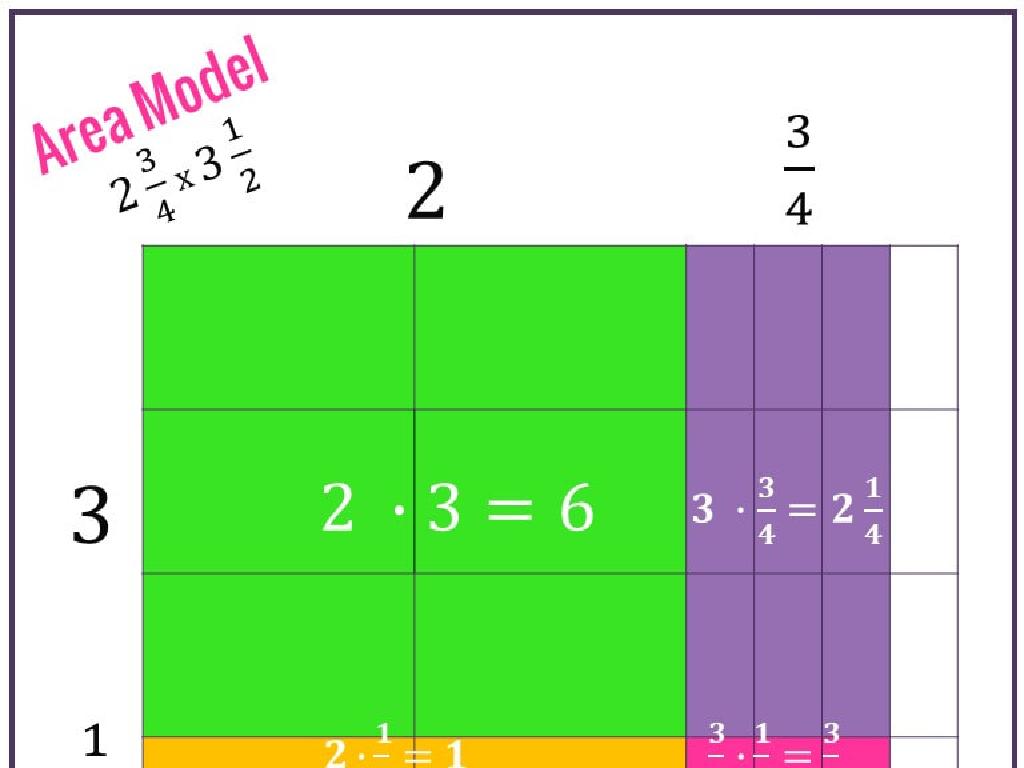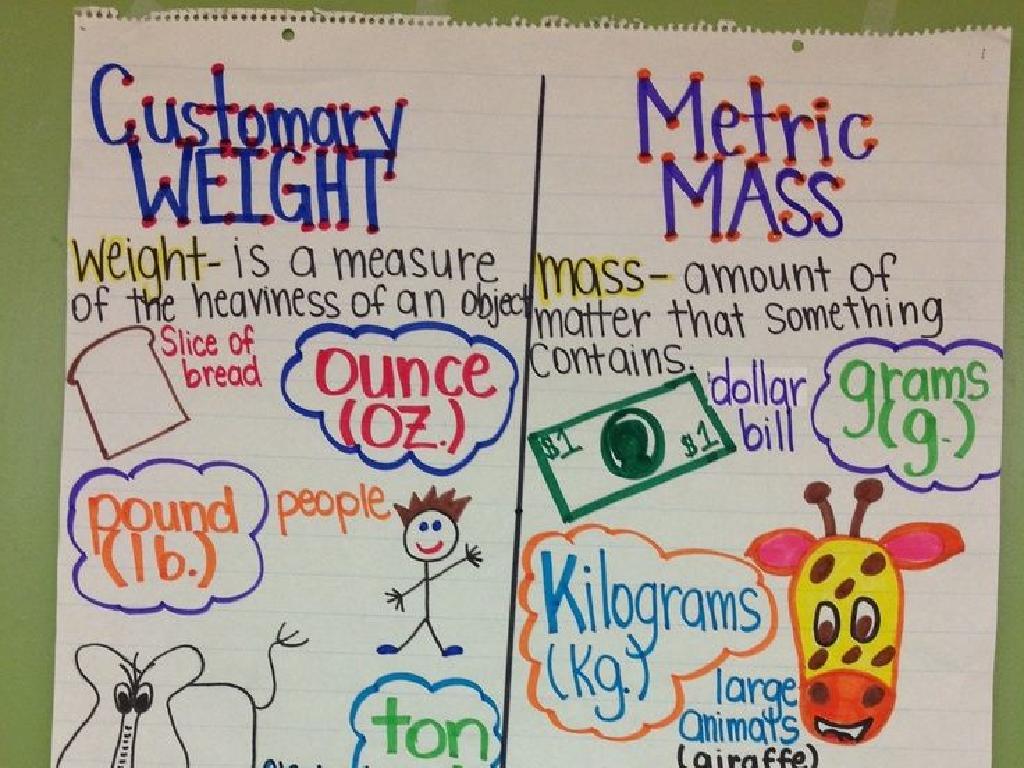Multiplication Facts For 6, 7, 8, And 9
Subject: Math
Grade: Third grade
Topic: Multiplication Fluency Up To 10
Please LOG IN to download the presentation. Access is available to registered users only.
View More Content
Today’s Adventure: Multiplication Facts for 6, 7, 8, and 9!
– Multiplication as repeated addition
– If you add 7 four times, it’s like 7×4!
– Multiplication: A math superpower
– It helps us solve problems faster than addition.
– Practice with 6s and 7s
– Let’s multiply 6 by numbers 1-10, then do the same with 7.
– Conquering 8s and 9s
– Next, we’ll master multiplying 8 and 9 by numbers 1-10.
|
This slide introduces students to the concept of multiplication as a form of repeated addition, which is a foundational step in understanding how multiplication works. Emphasize that multiplication is a powerful tool that makes calculating large quantities quicker and more efficient. Start with the 6 and 7 times tables, as these can be trickier for students to memorize. Use visual aids like arrays or number lines if possible. Then, move on to the 8 and 9 times tables, using similar methods. Encourage students to look for patterns and use them to remember the facts. Provide plenty of practice opportunities and consider using games or group activities to make the learning process fun and engaging.
Multiplication Warm-Up: Facts up to 5
– Review multiplication up to 5×5
– Engage in group quick-fire round
– Students answer rapid questions in groups to reinforce memory
– Encourage questions from students
– Address any uncertainties or confusions
– Prepare for facts 6, 7, 8, and 9
|
Begin the class with a quick review of multiplication facts up to 5 to ensure a strong foundation before introducing new facts. Organize a group activity where students can participate in a quick-fire round to answer multiplication questions, fostering a fun and competitive learning environment. This activity will help students recall facts quickly and accurately. Encourage students to ask questions if they’re unsure about any of the facts reviewed. This will help clear up any confusion and prepare them for learning the multiplication facts for 6, 7, 8, and 9. The teacher should have a list of multiplication questions ready and provide positive feedback to keep the students motivated.
Mastering the 6 Times Table
– Counting by sixes
– Skip count: 6, 12, 18, 24, …
– Understanding 6 x 3
– Like adding 6 three times: 6 + 6 + 6
– Practice: 6 x 2, 6 x 4, 6 x 5
– Let’s solve these as a class!
|
This slide is focused on helping third-grade students understand and memorize the multiplication facts for 6. Begin by engaging the class in a counting exercise by sixes to familiarize them with the sequence. Explain that multiplication is similar to adding the same number multiple times, using 6 x 3 as an example. Emphasize that 6 x 3 means adding three groups of 6. For practice, work through 6 x 2, 6 x 4, and 6 x 5 with the class, encouraging students to use the counting by sixes strategy to find the answers. Provide additional examples if time allows and ensure to praise students for their efforts to build confidence.
Multiplication Magic with Number 7
– Discover the 7 times table
– Think of 7 as your lucky number in math!
– Understand 7 x 4 with groups
– Imagine 4 groups of 7 items; how many in total?
– Let’s practice 7s together
– We’ll solve 7 x 1, 7 x 3, and 7 x 6 as a team
– Mastering 7s boosts math skills
|
This slide introduces the multiplication facts for 7, aiming to build fluency and confidence in third-grade students. Start by engaging them with the concept of 7 being a ‘lucky number’ in math. Use visual aids or physical objects to demonstrate the concept of grouping, such as 7 x 4 being four groups of seven items. During practice time, work through the problems 7 x 1, 7 x 3, and 7 x 6 together, ensuring that students understand the process and can visualize the multiplication as repeated addition. Encourage students to share their answers and explain their thinking. This interactive approach helps solidify their understanding and recall of the 7 times table.
Great Eights: Mastering the 8 Times Table
– Understanding the 8 times table
– Example: 8 x 2 as groups of 8
– Think of 8 x 2 as adding 8 twice: 8 + 8
– Practice: Solve 8 x 3, 8 x 5, 8 x 7
– Let’s multiply together and find the answers
– Tips for mastering multiplication
– Use patterns and repeated addition to learn
|
This slide introduces the 8 times table to third graders, emphasizing the concept of multiplication as repeated addition. Start by explaining that multiplying by 8 is like adding a number 8 times. Use visual aids, such as grouping objects in eights, to help students understand the concept. Work through the example provided, showing that 8 x 2 is the same as adding two groups of 8. Then, practice the 8 times table with the class by solving 8 x 3, 8 x 5, and 8 x 7 together. Encourage students to look for patterns and use them to remember the facts. Provide tips for mastering multiplication, such as doubling the 4 times table or adding 8 to the previous multiple of 8. The goal is to build fluency and confidence in using the 8 times table.
Multiplying with Niners!
– Learn the 9 times table
– Remember, 9s are fine! Let’s multiply with 9.
– Example: 9 x 3 as groups
– Think of 9 x 3 as adding three groups of 9 together.
– Practice time: 9 x 2, 9 x 4, 9 x 6
– Let’s solve these as a class: 9 x 2 = ?, 9 x 4 = ?, 9 x 6 = ?
– Discover patterns in 9s
– Notice anything special when you multiply by 9?
|
This slide is focused on teaching the multiplication facts for 9. Start by introducing the 9 times table and emphasize the pattern that emerges when multiplying by 9. Use an example like 9 x 3 to show how multiplication is similar to adding groups of the same number. During practice time, work through 9 x 2, 9 x 4, and 9 x 6 with the class, encouraging students to participate and share their answers. Highlight the patterns they might see, such as the digits of the products adding up to 9. This will help students to remember their 9 times table more easily. Make sure to provide positive reinforcement as they grasp the concept.
Tricks for Tougher Tables: Multiplying by 6, 7, 8, and 9
– Learn the 9s finger trick
– Bend the finger for the number you’re multiplying by 9. The fingers to the left are tens, to the right are ones.
– Discover table patterns
– Look for repeating sequences or shortcuts in the 6, 7, 8, and 9 times tables.
– Group activity on patterns
– Work together to find patterns in the 6, 7, 8, and 9 times tables.
– Share findings with class
– Each group will present the patterns they’ve found to the class.
|
This slide introduces students to helpful strategies for mastering the more challenging multiplication tables. Start by demonstrating the finger multiplication trick for the 9s, which is a fun and interactive way to remember the 9 times table. Next, guide students to observe and discover patterns within the multiplication tables, such as the digits in the 9 times table adding up to 9. For the group activity, divide the class into small groups and assign each group a number (6, 7, 8, or 9) to explore and find patterns in that multiplication table. Encourage creativity and critical thinking. After the activity, have each group share their findings with the class, reinforcing their learning through teaching others. This collaborative approach not only solidifies their understanding of multiplication facts but also enhances their communication skills.
Let’s Practice Multiplication Together!
– Interactive flashcard practice
– Use flashcards to review 6, 7, 8, 9 times tables
– Pair up for a multiplication quiz
– Take turns quizzing your partner on multiplication facts
– One-minute multiplication challenge
– See how many facts you can solve in 60 seconds
– Share your scores with the class
|
This slide is designed to engage students in active practice of multiplication facts for 6, 7, 8, and 9. Begin with interactive flashcard practice to help students visualize and memorize the facts. Then, have them pair up and quiz each other to reinforce their learning and encourage peer interaction. Introduce a fun time challenge where students try to get as many multiplication facts correct as possible within one minute, fostering a sense of urgency and excitement. Conclude by having students share their scores to celebrate their progress and identify areas where they may need further practice. This activity not only aids in memorization but also helps to build a supportive classroom community.
Multiplication Games: Let’s Play and Learn!
– Applying multiplication through play
– ‘Multiplication Race’ board game
– Play in small groups, roll dice and solve problems to advance
– Correct answers move you ahead
– Each multiplication fact you get right helps your piece sprint forward
– Team up and challenge friends
|
This slide introduces a class activity designed to reinforce multiplication facts for 6, 7, 8, and 9 through an engaging board game called ‘Multiplication Race.’ Divide the class into small groups and provide each group with a game board, dice, and game pieces. Students will take turns rolling the dice and moving their pieces forward on the board by correctly answering multiplication questions. This activity not only helps students practice their multiplication facts in a fun, competitive manner but also encourages teamwork and critical thinking. As a teacher, circulate around the room to assist any group needing help with the problems and to ensure that the game is played fairly. Prepare variations of the game for different skill levels if necessary, and consider offering small rewards for the winning teams to motivate participation.
Class Activity: Multiplication Art
– Create a colorful multiplication grid
– Highlight patterns with colors
– Use colors to show multiples of each number
– Share your art with the class
– Explain the patterns you see
– For example, show how 6×2 and 2×6 are the same
|
This activity is designed to help students visualize multiplication facts and recognize patterns, reinforcing their fluency in multiplication for numbers 6 through 9. Provide students with a grid template and colored pencils or markers. Guide them to fill in the grid with the products of the multiplication facts for 6, 7, 8, and 9. Encourage them to use a different color for each number’s multiples to create a visual pattern. Once completed, have each student present their multiplication art to the class and explain the patterns they observed, such as the commutative property of multiplication (e.g., 6×2 is the same as 2×6). This will help solidify their understanding of multiplication facts through a creative and engaging activity.
Multiplication Mastery: Homework
– Congratulations on learning new facts!
– Homework: Worksheet for facts 6-9
– Complete the provided worksheet to practice multiplying numbers 6 through 9.
– Daily practice strengthens skills
– Consistent practice is key to memorizing these facts.
– Aim for multiplication fluency
– Fluency means solving these quickly and accurately.
|
This slide is designed to congratulate the students on their hard work during the lesson and to assign them homework to reinforce their learning. The homework consists of a worksheet focused on the multiplication facts for 6, 7, 8, and 9. Emphasize the importance of daily practice to build fluency, which is the ability to solve multiplication problems quickly and correctly. Encourage students to take their time with the worksheet and to use strategies learned in class to find the answers. Remind them that practice is essential for mastery and that they should aim to become more fluent with each practice session. Offer some tips for practicing at home, such as using flashcards, playing multiplication games, or teaching someone else the multiplication facts.





